 Hungary Mozart (selection) and Orff’s Carmina Burana: Soloists, Hungarian State Opera ensembles / Tibor Bogányi (conductor). Budapest Opera House, 6.4.2025. (AK)
Hungary Mozart (selection) and Orff’s Carmina Burana: Soloists, Hungarian State Opera ensembles / Tibor Bogányi (conductor). Budapest Opera House, 6.4.2025. (AK)

Carl Orff’s Carmina Burana may be termed as a cantata or oratorio but, right from the start, Orff envisaged it as secular songs for three vocal soloists and chorus, accompanied by an orchestra and magical images. Having conducted the work many times in regular cantata or oratorio setting, conductor Tibor Bogányi was inspired to create the piece – after long years of dedicated teamwork with experts in the field – as a full-on theatrical experience with the addition of three ballet dancers and, crucially, with magical 3D images produced on six projectors and LED walls.
As Carmina Burana is about one hour long, the Hungarian State Opera has come up with a variety of solutions for their so far over fifty performances of this production (premiered in 2018) to provide a full evening at the opera house. Their solution for the performance which I attended was to start the evening with an educational overview of Mozart operas. A music historian (Dániel Mona) talked in Hungarian about opera, in particular about Mozart, while most of what he said was projected with large text (and pictures) onto the closed curtains in English. The orchestra was on the stage; two solo singers, the chorus (singing from the balconies) and the conductor were drawn from the Carmina Burana performers.
I am in two minds about this Mozart-Carmina Burana solution. It is likely that many in the audience were tourists who came only to do a task on their touristic lists but were unfamiliar with the genre of the opera. Educating and thus encouraging people to embrace the art is good. However, presenting non-staged and non-costumed bits and pieces from operas may not achieve the aim. And there is also a question of preserving the strength of performers. Singing isolated but exposed Mozart arias and choruses as a first act before a full-on theatrical presentation of Carmina Burana may be counterproductive.
I was amused by the order in the Mozart section of the evening. It started with an overture, it also concluded with an overture and it had a finale in the middle:
The Abduction from the Seraglio – Overture
Così fan tutte – ‘Una donna a quindici anni’ – Despina’s aria from Act II
The Magic Flute – Finale
Don Giovanni – Serenade Act II and Champaigne aria Act I
The Marriage of Figaro – Overture
For the text of his cantata/oratorio Carmina Burana, Orff selected 24 songs from the thirteenth-century manuscript ‘Carmina Burana’ (‘Songs of Beuern’) but did not use the musical notation of the old songs. The piece starts and concludes with the powerful ‘O Fortuna’, while the 23 songs in between tell about spring time, dances, tavern encounters and love.
The forces required by Orff’s score are huge. Apart from three solo singers and two choruses, the orchestra is unusually large requiring, for instance, two pianos, a celesta, five timpanis, three bells, three xylophones, castanets, a triangle, a tam-tam, a snare drum, a gong, cymbals and the full symphony orchestra.
Tibor Bogányi is the conductor as well as the stage director of his cherished project which implements Orff’s dream of including magical images for performances. He closely collaborated with his wife – musician/painter Ágnes Zászkaliczky – and Freelusion that is a video mapping studio and dance ensemble.
The essence of this staging is the music. The 3D images follow the musical progression in real time. All of the images are marked in the score which is closely followed by the artist controlling the projection. If the conductor takes a slower tempo or faster tempo, the images are relayed accordingly.
The performance I saw was as mind-blowing as mesmerising in all dimensions. Conductor Bogányi has every second of the score in his whole being and creates beauty, excitement and art at its best.
The choruses – the adult as well as the children’s choir of the Hungarian State Opera – were very impressive. They sang the extensive old Latin, German and French texts from memory. As an old time music teacher of all ages, I was particularly impressed by the children: their crystal-clear pitching and charming acting brought tears to my eyes.

Full praise goes to the three ballet dancers who interpreted music and text with imaginative choreography in the upper layer of the vertically divided stage. The orchestra, too, gave full support to the conductor, thus to the concept.
The three solo singers rose to the challenge of delivering music and drama at a high standard, in what might have been a technically difficult scenario for them. Full credit to baritone Gyula Nagy who maintained vocal beauty (including some lyrical falsetto in one of the songs) in spite of delivering two arias from Don Giovanni in the first half of the evening.
I am not competent to give adequate description of the full 3D experience, so here comes a more reliable taster.
Agnes Kory
Cast:
Eszter Zemlényi (soprano), Andrea Meláth (alto), Gyula Nagy (baritone)
Kristina Starostina, Iurii Kekalo, Ricardo M.Vila (dancers)
Production:
Concept – Ágnes Zászkaliczky, Attila Könnyű, Tibor Bogányi
Artistic directors – Ágnes Zászkaliczky, Tibor Bogányi
Stage direction – Tibor Bogányi
3D visual projection – Freelusion
Choreography – Timea Papp
Costumes – Mónika Szelei
